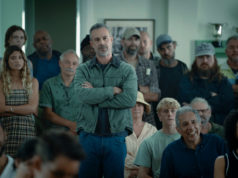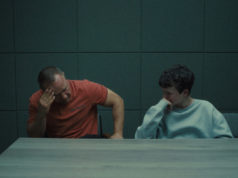Just as I did last year, I start off my cinematic blog posts with a list of the year’s best documentaries. Back in August, Cinematical mused that this year might be special for nonfiction films, and indeed it seems as this year’s selection has been extraordinarily rich. Moviegoers here have been lucky to have a chance to see many of these (though still not enough) in local theaters. This list is so deep that Waiting for “Superman” (chosen by my colleagues at the DFW Film Critics Association as the year’s best documentary and a probable front runner for the Oscar) is nowhere near my Top 10. In fact, I could have run this list for best movies of the year and been proud of it.
1. Exit Through the Gift Shop: One of the funniest movies I saw all year, fiction or documentary. French expatriate Thierry Guetta set out to make a film about the reclusive street artist known as Banksy, only to have the reverse happen. Banksy (who appears on camera in heavy disguise) details how Guetta — inspired by the artists whom he hung out with — took to creating art and became richer and more famous than Banksy and all his colleagues, even though Guetta’s art sucks massively. If this were fiction, we’d say the satire on the art world was cheap and hokey. But it all really happened, and Banksy wonders who’s the fraud, Guetta or himself.

2. Last Train Home: I keep a file of reasons why China won’t be the next global superpower, and Fan Lixin’s movie is more fodder for it. His film focuses on the Zhang family, two parents working grueling hours in Guangzhou while their daughter stays in the countryside thousands of miles away to be raised by her grandmother. Like most workers, the Zhangs can only see their child once a year on Chinese New Year. The film takes in the massive scope of migration as hundreds of millions of workers spend that holiday traveling the country’s overworked transportation system, yet it also totes up the damage caused by the Zhangs spending most of their time away from home. Until China gives these people more benefits and more dignity, it will be a step behind the Western world.

3. Inside Job: Charles Ferguson lays out how America’s financial sector led the country to ruin, by convincing politicians that they were doing hideously complicated work that only they themselves could understand or regulate, by convincing millions of working Americans to take bad loans and buy houses they couldn’t afford, and by convincing academics that free-market principles always resulted in good things. It’s enraging to see how these Wall Street types got away with golden parachutes while their investors were left with nothing.

4. Restrepo: Tense and draining like an action-thriller, Tim Hetherington and Sebastian Junger’s film beds in with a platoon of U.S. soldiers as they build a fortress in the Taliban-controlled Korengal Valley in Afghanistan and spend a year defending it against heavy attack. You can feel the adrenaline hanging in the mountain air as the soldiers fight off enemy insurgents, try to bring local chieftains over to their side, while away their off hours, and mourn their fallen comrades like the soldier after whom their outpost and the movie are named.

5. Marwencol: The opening night selection at last month’s Lone Star Film Festival, Jeff Malmberg’s film draws a portrait of Mark Hogancamp, a former Navy sailor and drunken brawler who turned to creating art in his backyard after a bar fight left him with severe brain damage. Hogancamp’s scale model World War II village — and the extensive mythology that he’s invented for the place — is perhaps the most wondrous thing any documentary shows us all year, and seeing his work give new purpose to his life is as inspiring as any Hollywood film.

6. The Two Escobars: Produced as part of ESPN’s 30 for 30 series, Jeff and Michael Zimbalist’s film recounts the stories of Pablo Escobar, the soccer team owner who ruled the Colombian cocaine trade in the early 1990s, and Andrés Escobar, the unlucky Colombian soccer player who accidentally scored into his own net for USA at World Cup 1994 and was murdered shortly afterward. In tracking these two unrelated men who shared a last name and a passion for sport, the movie shows how drug money fueled Colombia’s rise in global soccer while also containing the seeds of its destruction, and how the country and the game are recovering.

7. The Tillman Story: Investigating the friendly-fire death of a football player-turned-soldier, Amir Bar-Lev’s film turns up all sorts of unseemly behavior up the chain of command. While generals and politicians debase themselves trying to contain the p.r. damage from the killing of their most famous enlisted man, Tillman’s family keeps on with their quest to find the truth about what happened to their son and brother. Their courage is something to behold.

8. Racing Dreams: Marshall Curry is neither jaded nor starstruck as his film follows three preteen competitors in the World Karting Association who dream of one day racing in NASCAR. We flinch at the corporate schmoozing that these children must learn to do and at the cold realities of the sport that filter down even to this level, yet we also thrill to the excitement of the races and the primal joys of going fast.

9. Casino Jack and the United States of Money: Alex Gibney is a documentarian with a flair for entertainment, so it’s no surprise that his account of the shenanigans of Jack Abramoff comes off as more fun than the current dramatization Casino Jack. Abramoff’s career exposed the American political system at its cynical worst, and Gibney finds great sport in that and the bodybuilding schlock movie producer who made it all possible.

10. I’m Still Here: Casey Affleck’s filming of his brother-in-law Joaquin Phoenix’s yearlong meltdown (and abortive music career) engendered lots of talk before filmmaker and subject admitted it was all just an elaborately staged prank. It all seems rather self-fulfilling now; Affleck and Phoenix are out to prove that fans and press are inherently vicious, so they do things guaranteed to bring out that reaction. Even so, it’s compelling to see Phoenix (looking like Zach Galifianakis with the extra weight and full beard) trawling for hookers online, befuddling David Letterman on his show, and rapping like a guy who’s never actually heard hip-hop music but is trying to make it based off written descriptions that he’s read. Much of this movie is entertaining. Almost all of it is appalling.

Honorable mention: Ricki Stern and Anne Sundberg’s Joan Rivers: A Piece of Work, Yael Hersonski’s A Film Unfinished, Chris Hegedus and D.A. Pennebaker’s Kings of Pastry, Lucy Walker’s Countdown to Zero.












I hope the Oscar judges are also moved by “The Tillman Story”. Amir Bar-Lev’s film contributed to restoring Pat’s legacy by honoring the man, not the myth. The iconoclast, not the icon. As his mother said, “Pat would have wanted to be remembered as an individual, not as a stock figure or political prop. Pat was a real hero, not what they used him as.”
However, Amir Bar-Lev’s film ended the story too soon. Last July, I sent him a letter (see “The [Untold] Tillman Story” at http://www.feralfirefighter.blogspot.com) arguing that his film would have more impact if it also told the “untold story” of how President Obama and the Democratic Congress continued the Army & Bush administration cover-up of Tillman’s friendly-fire death.
Instead, “The Tillman Story” was largely ignored since it didn’t reveal any “news” about the Tillman story. The film wasn’t controversial, it threatened none of those politicians still in office. Gen. McChrystal, who personally led the cover-up, was barely a footnote in the film and is off making $50,000 on the lecture circuit … meanwhile, the film is no longer showing after peaking at only 28 screens.
Just before the 2006 mid-term elections, Kevin Tillman published his eloquent letter, “After Pat’s Birthday”. Kevin had hoped a Democratic Congress would bring accountability back to our country. But, just as with warrantless wiretapping and torture, those responsible for the cover-up of his brother’s friendly-fire death have never been held accountable for their actions.
To learn more about the Tillman story, I’d suggest Mary Tillman’s “Boots on the Ground by Dusk” (revised paperback at blurb.com), Jon Krakauer’s paperback edition of “Where Men Win Glory”, or the http://www.feralfirefighter blogspot.com
And of course, see “The Tillman Story” on DVD after it’s 2/1 release. Hopefully, Amir Bar-Lev has added footage to the film’s DVD extras that will tell more of this “untold story”.
Where’s GASLAND by Josh Fox? A big winner at Sundance and on the short list for an Oscar. And it has local meaning. Have you seen it? Now on DVD.